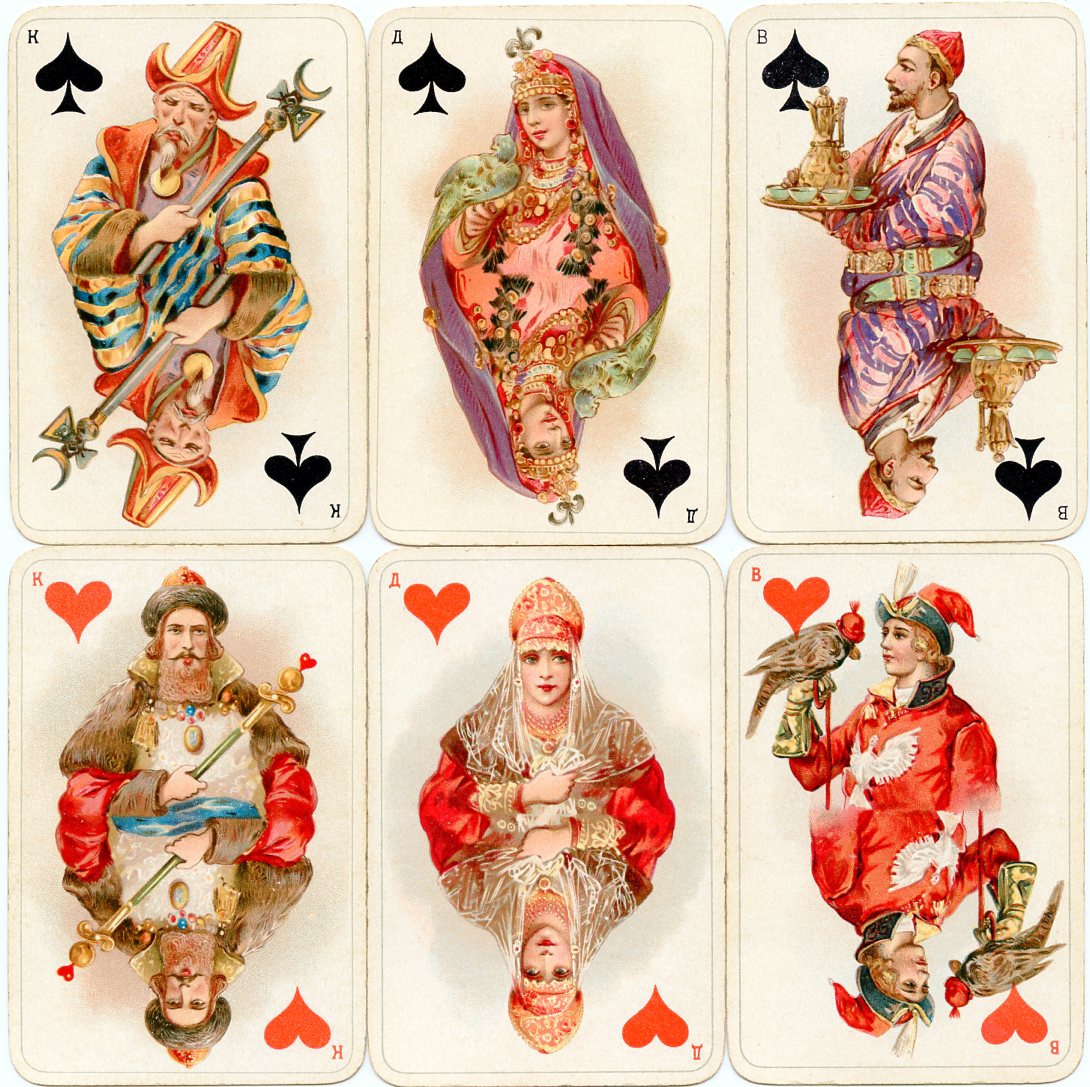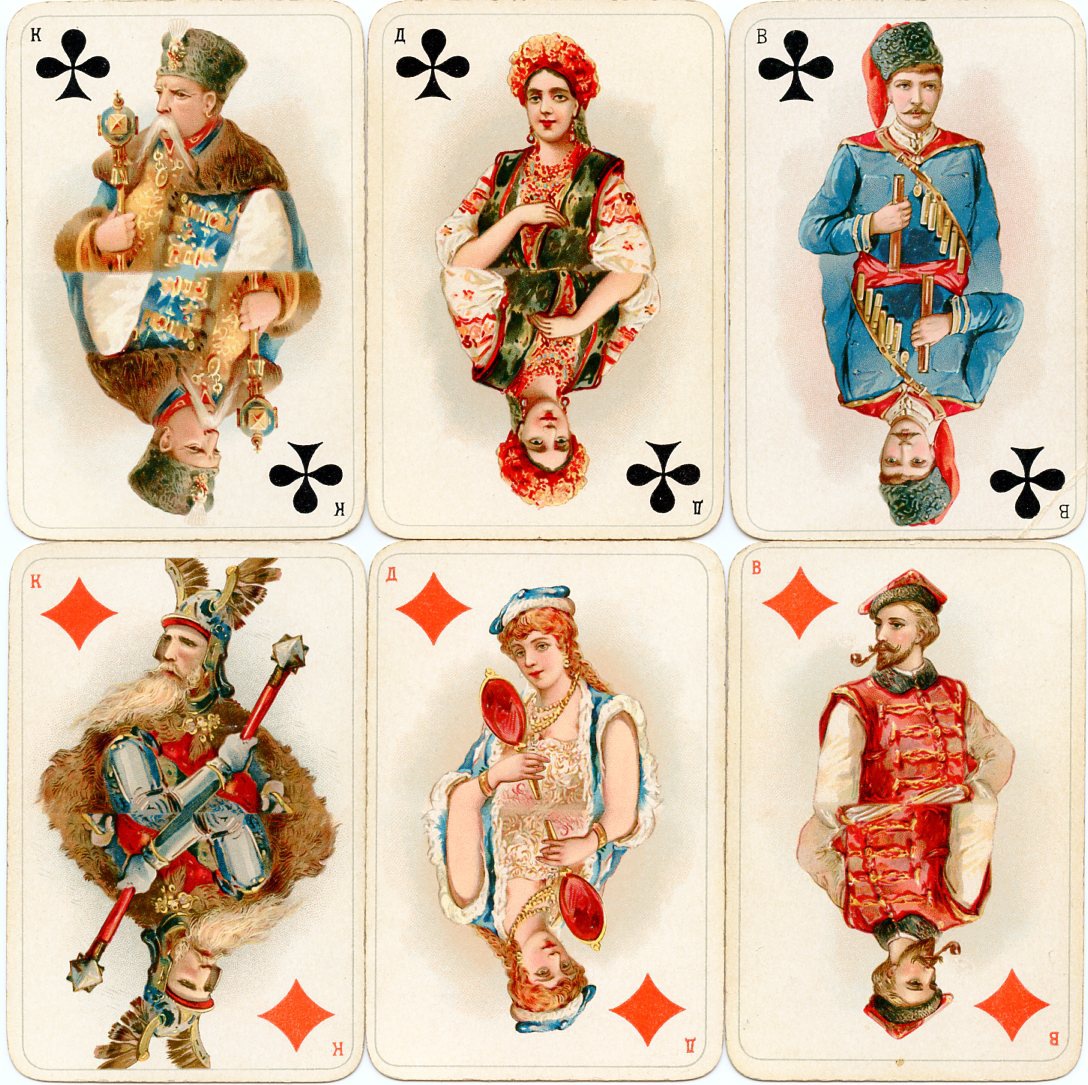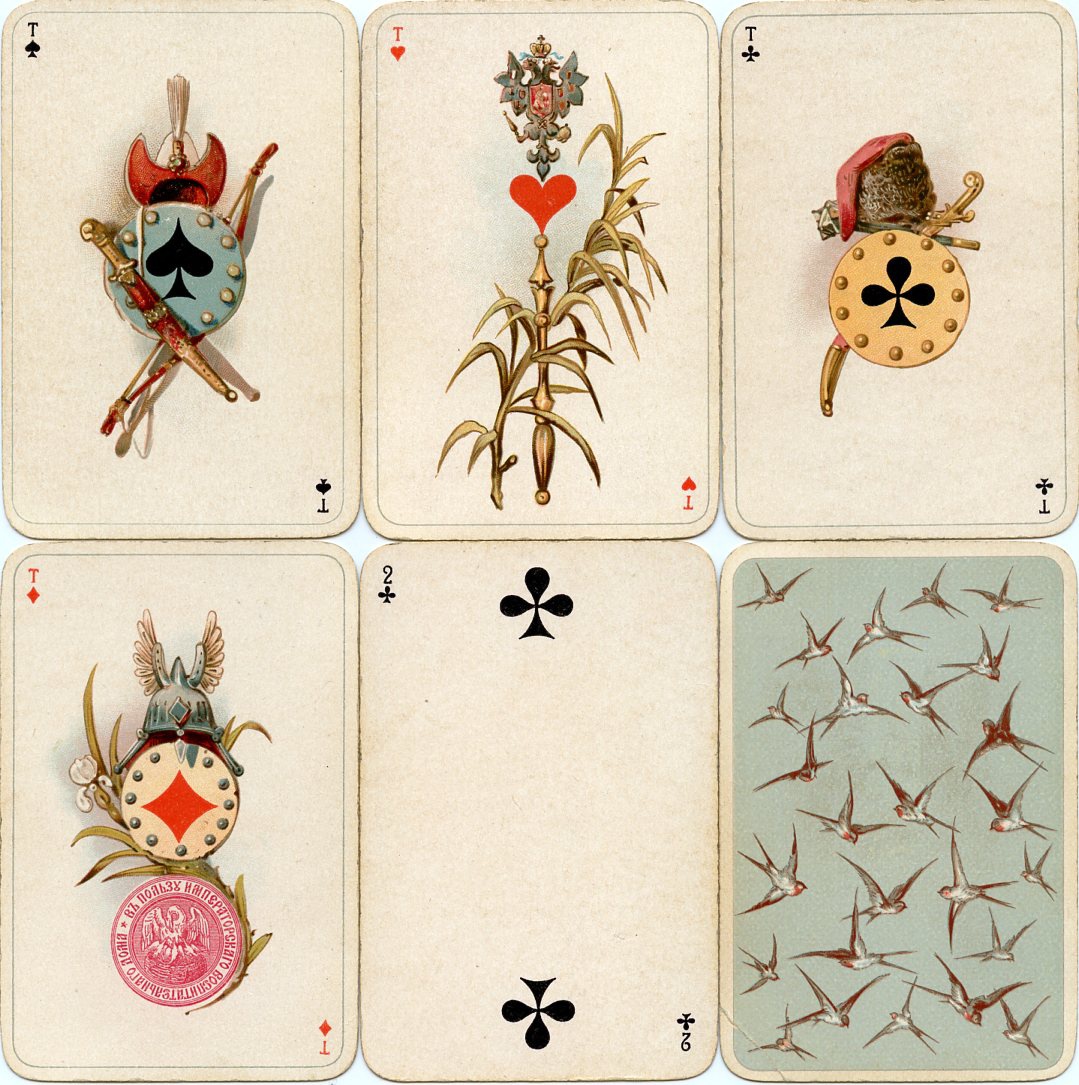
June 1
Almost
at the end of the lockdown series now, but the very last deck will follow
tomorrow…….. after my dinner at the Boekanier in Zaandam. Until now I've
chosen the decks a bit hap snap in the last hour, just pulling some holder and
browsing through the sheets. Today's lockdown deck comes from one of the Russian
holders. It's from the first edition of the "Historical" deck, printed
in fine chromolithography by the Imperial Printing Plant in St. Petersburg and
published in 1897. The deck was designed by Nikolai Karazin. There was a second
edition in 1898, in which the figures of the JC and JS were changed and small
changes were made to the design of the KH.
COMMENTS:
Laherte
Guerra:
Each
suit stands for a nationality in the Russian Empire: spades - Kyrgyz, hearts -
Russians, clubs - Ukrainians and diamonds - Lithuanians.
Eduard
Schweigert:
Laherte Guerra, Lithuanians, Not Poland?
Radoslaw
Repa:
Eduard Schweigert
that's
my impression also. Diamonds are rather a kind of Polish-Lithuanian nobles.
Queen and Jack are wearing "rogatywka" (four-cornered cap), which in
19th cent. was considered as a patriotic symbol. The King has something...,
well, it's hard to say what it is; a type of helm for sure. The wings look like
miniature hussar wings, but
it's the result of the author's fantasy. The winged helms were used, but they
looked rather like that.
Eduard
Schweigert:
Ich
schreibe in Deutsch. You can Translate
Also,im März 1900 russische Magazine „Ogonek“(Kleine Flamme) schrieb über
diese Spiel,unter anderen,dass Farbe Karo steht für Polen.
Laherte
Guerra:We
are in face of late-19th century romantic, stylised renderings on playing-card
faces, this is not serious history painting. I see the king of diamonds as a
Viking Rus', a people long present in Baltic lands, since winged helmets were
(and sitll are) a cliché at depicting Norsemen; the headgear was also painted
on the respective ace.
On the other hand, Radoslaw Repa identifies the queen's and jack's garments as
Polish(-Lithuanian?), not the same about the king though. The article from 1900
in the Russian magazine "Огонёк"
that he brings had all the diamond figures as Polish, the imposing elder on the
king card been laconically described as "an old Pole with a long grey
beard".
However, one must remark the seemingly indistinct use of the terms "Kirghiz
or Bashkir", Tatar and even Kalmyk(!) in reference to the spades suit,
which leds me to think ethnographic accuracy was not the author's strongest
point or his/her minimal worry, and that he/she was not better informed about
the art on the pack of cards, 3 years after its first release, than we are these
days.
I believe Nikolai Karazin has intended to broadly represent the past of peoples
from the then western limits of the Empire once organised in the
Polish-Lithuanian Commonwealth, just like I suppose Radoslaw does.
The alternative to this view would be accepting an extremely fantasist depiction
of an old Polish duke from?... wearing an inexplicable helmet associated to
medieval Scandinavian warriors by a well established convention. The same winged
helmet also shows prominently on the ace of diamonds: Karazin really saw it as
an important symbol.
Eduard Schweigert: Laherte Guerra man kann darüber viel diskutieren,aber wie Sie selber sehen,es gibt verschiedene Interpretationen,nur nicht definitiv Lithuania. „Огонёк» war zeitgenössische Kommentator und hat bestimmt ein Grund dafür,diese Figuren als polnische zu beschreiben. Obwohl mit dem King als mythologische Skandinavischen „Warrior“ bin ich einverstanden.
Laherte
Guerra:
Eduard
Schweigert Agreed, that's why I now favour identifying the Diamond courts and
ace as generically "Polish-Lithuanian"-themed. We know Austrian packs,
mainly tarock, were dedicated to "peoples in the Empire" long
beforehand, balancing nationalisms, sincere curiosity and tastes for exoticism.
Although those are mere playing-cards, Karazin was not only an academic painter
but also well versed in geography and ethnography, he knew very well both the
then prevailing artistic conventions at depicting peoples from the past and what
regions in the Russian Empire had ever to do with Norsemen. Little Russia had
the suit of Clubs exclusively devoted to her though.
Radoslaw Repa: Dear Gentlemen (Laherte Guerra and Eduard Schweigert) thank you for your voices. I wrote about Q&J because I was thinking that we see division here: Kings are in military costomes and they are warriors and Q&j are "citizens" in folk costumes; 2. In 1819 Lithuania was a part of Russian Empire, Karazin probably knew the stereotypes according to which the people of Lithuania were divided to two main social classes: nobility and peasants, and the nobles were mainly Lithuanaian origin, but in 19th century they were rather Polish-speaking in opposite to Lithanian speaking pesants; 3. The Nordic inspiration is very likely and it would be interesting to see what the representations of Scandinavians and Slavs looked like in historical iconography at the time.
Laherte Guerra: No, thank YOU, Radoslaw, this is all very interesting. I suspect it might have been somewhat embarrassing to depict any old, even unnamed king of Poland or grand duke of Lithuania — the "natural" choices for the king of Diamonds i.m.o. N. Karazin also was a decorated military officer and participated in the repression to the January Uprising in Poland; I wonder if political sensitivities have led him to go back to the distant 9th century or so and to resort to a Viking Rus' or Varangian chieftain from a politically neutral pre-states era in order to still "represent" the lands of eastern Baltic in his pack of cards.
Radoslaw Repa: It could be a political choice, kind of escapism even. It could be also a kind of fashion in history paintings from Belle Époque. Being honest, I have no idea about the then archaeological knowledge about armaments from the 9th or 10th century. I can only guess and make guesses. For example, lets take a look at a picture "Arrival of the Hungarians" ("A magyarok bejövetel") by Arpad Feszty. It's a picture from 1894 and there, in the central part we may see a group of horse riders. Some of them have helmets decorated with feathers. maybe it was just popular artistic vision from these era? The King of Clubs looks like an ataman, so maybe Kings could be some generalization of the figure of a military leader.


